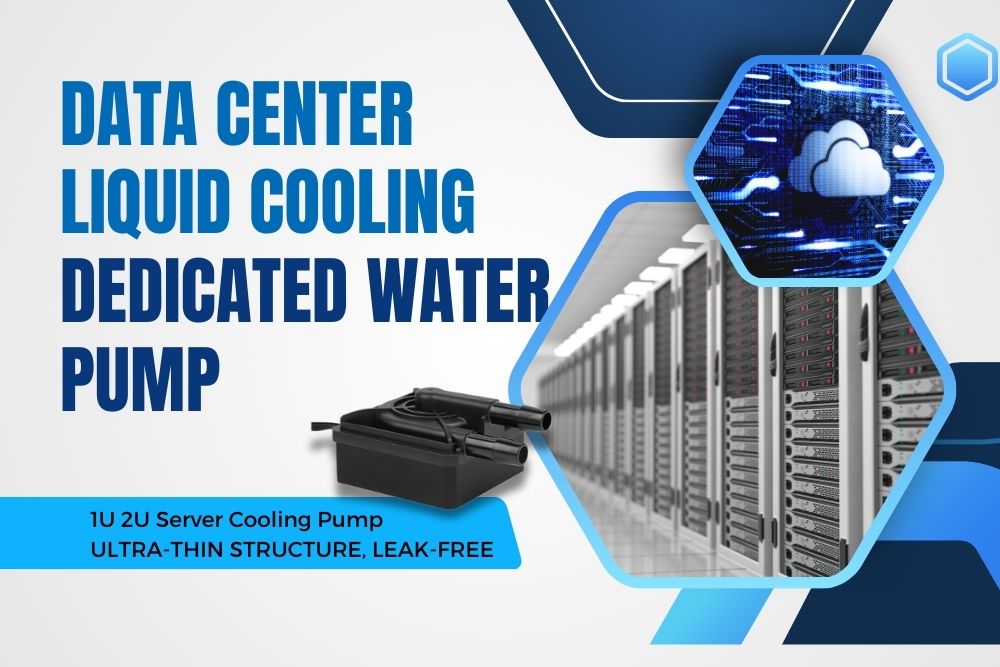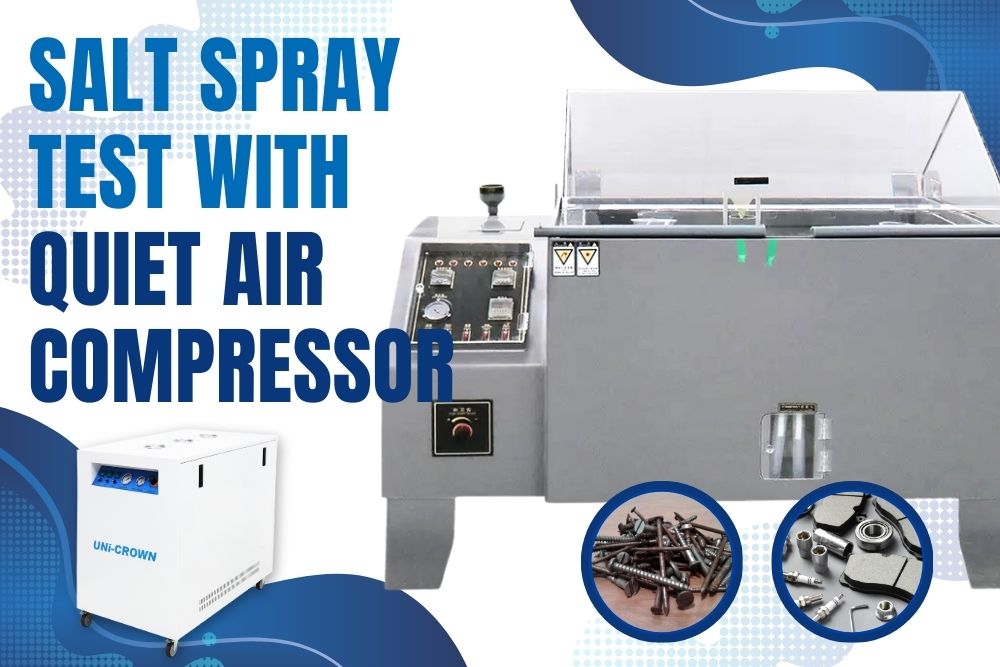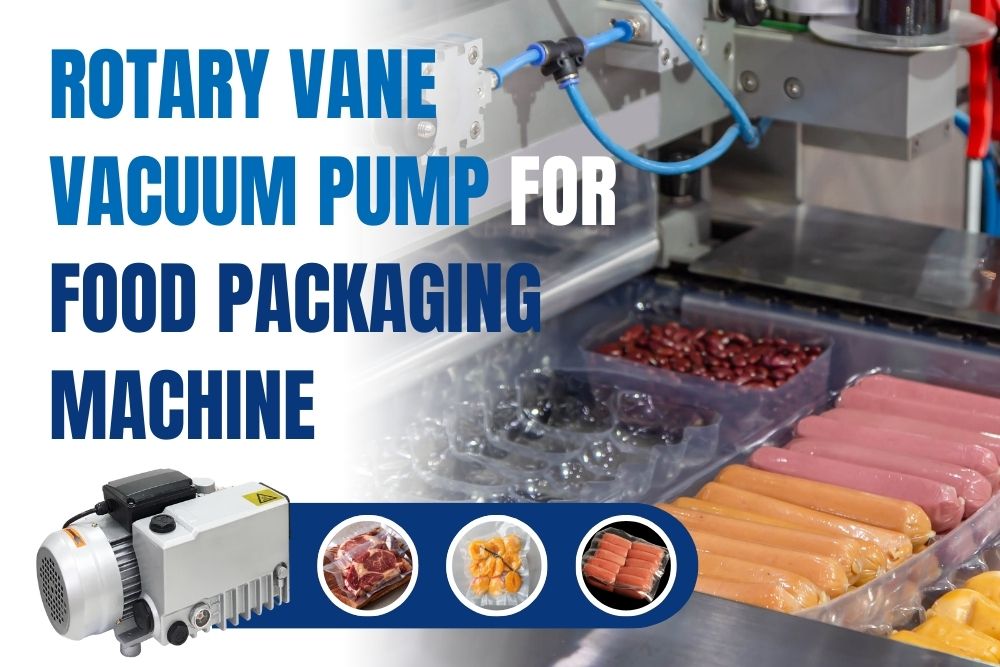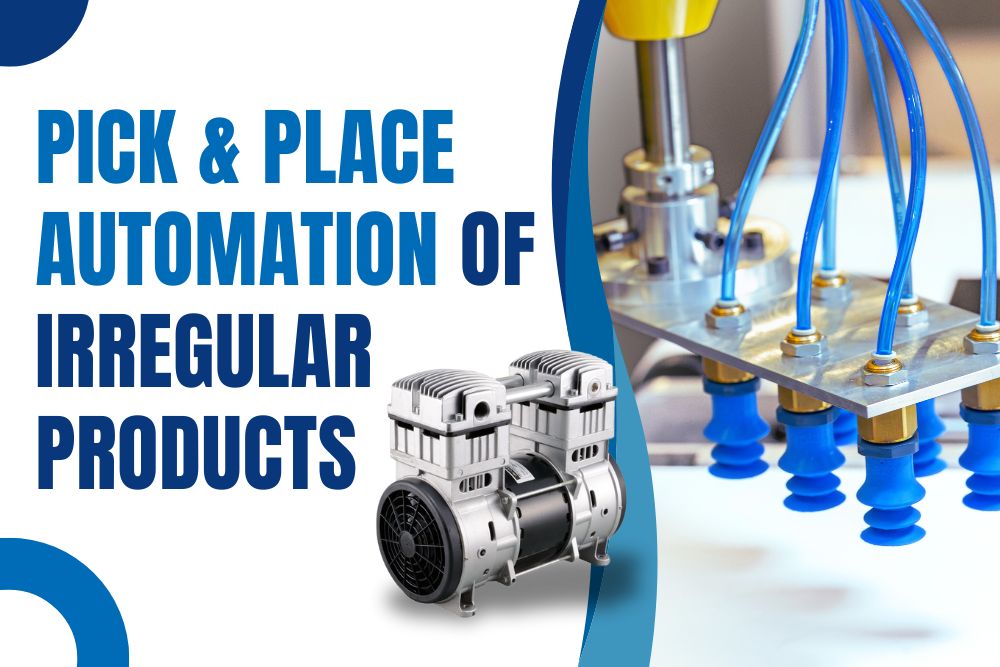In recent years, artificial intelligence (AI) technology has advanced rapidly, particularly in deep learning, cloud computing, and high-performance computing (HPC). The increasing demand for computing power has made power consumption and heat dissipation in high-performance servers a significant challenge. According to Taiwan’s Ministry of Economic Affairs Industrial Technology Department, the power consumption of high-end AI chips has reached 1000W, while traditional air cooling methods have a limit of approximately 750W. This indicates that air cooling is insufficient to meet the thermal management demands of AI servers. To address this issue, major companies have been actively developing liquid cooling technology, with liquid cooling pumps emerging as a critical solution for AI server and data center cooling. Liquid cooling technology not only improves cooling efficiency but also reduces energy consumption and carbon emissions, aligning with the green computing trend.
This article explores the development trends of Taiwan’s AI industry, compares different server cooling methods, and analyzes the applications and advantages of liquid cooling pumps in data centers and AI servers.
Table of Contents
1. Future Development of Taiwan’s AI Industry
2. Applications of AI Computing
3. AI Server Cooling Strategies: Analyzing Three Key Technologies
4. Market Challenges of Liquid Cooling for Servers
5. Liquid Cooling Pump Solutions for Server Cooling
1. Future Development of Taiwan’s AI Industry
Taiwan is one of the global leaders in semiconductor and AI hardware manufacturing. The growing demand for AI applications is driving the development of high-performance computing (HPC) and data centers. Key trends in the AI industry include:
• Increasing power consumption of high-end AI chips: AI training and inference models continue to advance, requiring higher-power GPUs, TPUs, and ASIC chips. AI-specific chips from NVIDIA, AMD, and Intel have surpassed 1000W in power consumption, making thermal management increasingly challenging.
• Higher server density: AI servers are evolving towards high-density designs, such as rack servers and GPU servers, leading to greater heat accumulation.
• Power and cooling challenges in data centers: Global data centers are focusing on reducing Power Usage Effectiveness (PUE) below 1.3 to minimize energy waste.
Key Development Focus:
As AI computing continues to grow, liquid cooling and immersion cooling technologies are becoming the future trend. Taiwan’s thermal management supply chain—including liquid cooling pumps, cooling fluids, and liquid-cooled server racks—will see substantial market opportunities.
2. Applications of AI Computing
AI computing has broad applications, including:
• Supercomputing: Used for complex scientific calculations and simulations, such as weather forecasting and genomic research.
• High-Performance Computing (HPC): Supports large-scale data analysis and engineering simulations, such as oil exploration and financial modeling.
• AI Training & Inference: Deep learning and large language model (LLM) training for speech recognition, inference, and image classification.
• Cloud Computing: AI inference services provided by AWS, Google Cloud, and Azure, enabling flexible computing resource deployment.
• Server Hosting: Supports enterprise IT infrastructure, including database management and ERP systems, ensuring high availability and reliability.
• Edge Computing: Performs calculations near the data source, reducing latency in applications such as IoT, smart factories, and smart cities.
• New Energy & Electric Vehicles: AI-driven battery management, energy optimization, and intelligent vehicle control systems to enhance efficiency and safety.
The demand for efficient cooling solutions is critical in these areas, making liquid cooling technology essential.
3. AI Server Cooling Strategies: Analyzing Three Key Technologies
As AI chip performance improves, thermal management is becoming a critical issue. Choosing the right cooling technology is essential for ensuring stable server operation. AI applications involve massive data collection and processing, which significantly increases power consumption and heat generation.
If heat is not effectively managed, high temperatures can impact chip lifespan, stability, and reliability. The direct consequences include reduced computing performance, slower data processing speeds, shorter lifespan, or even overheating failures. Therefore, effective cooling solutions are crucial for AI server design.
Air Cooling: The Most Common Cooling Method in Enterprise Data Centers
Heat Exchange Principle:
Air cooling relies on fans and heat sinks to dissipate heat from inside the server chassis to the external environment, maintaining stable server operation.
Advantages:
✅ Low Initial Cost: No need for major data center modifications, making it suitable for traditional setups.
✅ Easy Maintenance: Simple infrastructure with low management and maintenance complexity.
Disadvantages:
❌ Limited Cooling Capacity: Relies on fans and air conditioning, leading to high power consumption. Data center PUE typically ranges from 1.5 to 2.0.
❌ Insufficient for High-Power AI Chips: Traditional air cooling reaches its limit at around 750W, while high-end AI chips require over 1000W of cooling.
❌ Noise and Vibration Issues: High fan speeds generate significant vibration and noise, affecting both server stability and workplace quality.
Direct Liquid Cooling (DLC): Improving Cooling Efficiency & Reducing Energy Consumption
Liquid cooling uses fluids (such as deionized water or specialized coolants) to transfer heat away from the server. Depending on the heat dissipation method, it is categorized into Liquid-to-Air and Liquid-to-Liquid cooling.
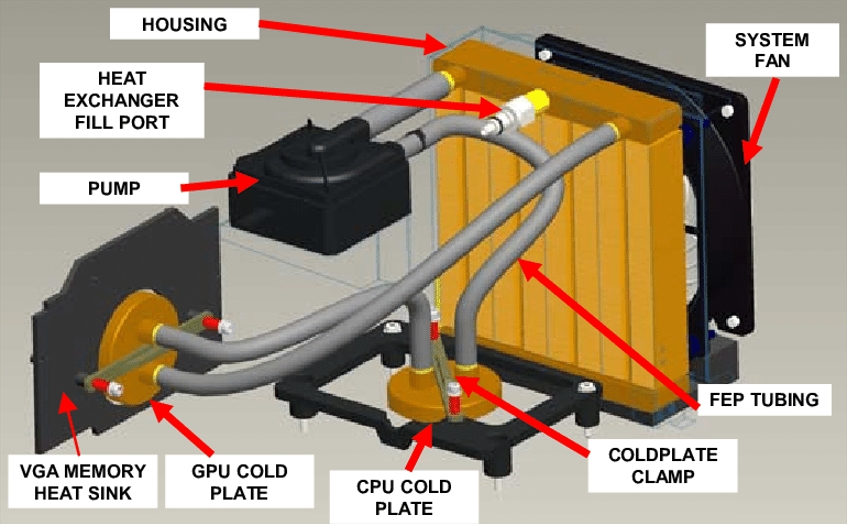
The working principle of the water cooling device is that through the contact between the pump head and the CPU, the cold water flows through the pump head and becomes hot water through the operation of the pump. The hot water flows to the cold radiator and transfers the heat to the cold radiator containing a large number of aluminum fins. , and then turns into cold water and returns to the pump head.
Liquid-to-Air Cooling:
Heat Exchange Principle:
Cooling liquid absorbs server heat and transfers it to the rear fan door, which then expels the heat into the air.
Advantages:
✅ Easy Deployment: Can be upgraded within existing air-cooled data centers without major modifications.
✅ Higher Energy Efficiency: Data center PUE can be reduced to 1.1–1.2, significantly lowering energy consumption.
Disadvantages:
❌ Still Requires Fan Assistance: Additional fans may generate noise.
Liquid-to-Liquid Cooling:
Heat Exchange Principle:
The cooling liquid circulates through a dedicated cooling system connected to external heat exchangers (e.g., cooling towers or chillers).
Advantages:
✅ Superior Cooling Performance: More effective than Liquid-to-Air for high-power AI servers.
✅ Extreme Energy Efficiency: Data center PUE can be reduced to 1.05–1.1, cutting operational costs.
Disadvantages:
❌ High Initial Cost: Requires dedicated liquid cooling infrastructure and additional cooling equipment.
❌ Data Center Upgrades Required: Cannot be retrofitted into air-cooled facilities without additional pipeline and water treatment installations.
Direct liquid cooling is becoming a preferred solution for high-power AI servers and cloud data centers. For example, Taiwan’s Industrial Technology Research Institute (ITRI) and Intel have co-developed kilowatt-level AI server liquid cooling solutions.
Immersion Cooling: The Ultimate Thermal Management Solution
Heat Exchange Principle:
Servers are fully immersed in dielectric coolant, allowing direct heat transfer from electronic components via phase change or circulation.
Advantages:
✅ Highest Cooling Efficiency: Data center PUE as low as 1.05, drastically reducing energy consumption.
✅ Ideal for High-Density Servers: Enables more powerful servers within compact spaces, perfect for AI computing and HPC.
✅ Low Noise & Vibration: No fans required, ensuring quieter operation and reduced mechanical vibration.
Disadvantages:
❌ High Infrastructure Cost: Requires specialized cooling tanks and fluid management systems.
❌ Maintenance & Compatibility Challenges: Coolant compatibility with server components requires extensive testing.
❌ Ongoing Technological Development: Standardization is still evolving, requiring ongoing material testing.
Although immersion cooling offers exceptional cooling performance, challenges such as material compatibility and standardization remain. However, with AI computing demands continuing to rise, this technology is set to become a key option for future high-performance data centers.
*PUE (Power Usage Effectiveness) is the standard metric for measuring energy efficiency in data centers. It is calculated as the ratio of a data center’s total power consumption to the power supplied to IT equipment. A lower PUE value indicates higher cooling efficiency, reducing energy costs. The ideal PUE ratio is 1.0, meaning that all power consumed by the data center is used for computing operations.
4. Market Challenges of Liquid Cooling for Servers
With the rise of AI computing and High-Performance Computing (HPC), traditional air cooling can no longer handle increasing power consumption and heat dissipation demands. Liquid cooling is becoming the mainstream solution. However, implementing liquid cooling in 1U/2U servers still faces several challenges:
1. Limited Design Space: Most server racks are designed for air cooling. Integrating a liquid cooling system presents spatial constraints. For example, a 1U server is only 4.445 cm in height, while a 2U server is 8.89 cm. Fitting cooling fluid channels, cold plates, and pumps within such a compact space is a significant design challenge.
2. Sealing and Leakage Risks: Core server components such as CPUs and GPUs are highly sensitive to liquid exposure. Any leakage could lead to short circuits or even total system failure. Thus, ensuring a high level of sealing integrity in pumps, tubing, and connectors is critical.
3. Cooling Efficiency and Stability: Studies show that over 55% of server failures are related to inadequate thermal management. When chip temperatures exceed 70°C, their reliability decreases by 50% for every additional 10°C. Poor pump performance or an improperly designed liquid flow system can cause localized overheating, leading to reduced computing performance or frequent system crashes.
5. Liquid Cooling Pump Solutions for Server Cooling
To address these challenges, UNi-CROWN Pump has developed the DC-C08-BL micro water pump, designed specifically for server liquid cooling applications. This high-efficiency, stable solution meets the spatial constraints of server racks while ensuring optimal thermal management.
1.Ultra-Compact Design for 1U/2U Servers
o The micro water pump is only 36mm thick, making it ideal for tight spaces.
o Customizable integrated pump and cold plate solutions maximize rack space utilization in data centers.
2.High-Sealing and Leak-Proof Design for System Safety
o Made with imported high-strength PPS material and precision-molded components.
o 100% rigorous leak-proof testing using French-imported airtightness detection equipment.
3.Durable Bearings & Suspended Rotor Technology for Extended Lifespan
o Features high-precision ceramic shafts and imported graphite bushings for reduced wear and lower failure rates.
o Suspended rotor technology ensures long-term stable operation, reducing maintenance costs.
o Motor lifespan >20,000 hours
4.Smart Monitoring & Variable Speed Control for Optimal Cooling Performance
o Max flow rate: 8L/min; Max head: 5M, ensuring efficient cooling.
o Built-in intelligent chip supports PWM speed control and signal feedback, allowing real-time monitoring and dynamic flow adjustment for stable server operation.
Why Choose Unicrown DC-C08-BL Water Pump?
The DC-C08-BL centrifugal liquid pump is engineered to deliver high flow, high head, and low power consumption, making it ideal for data centers. It supports multiple control modes (PWM, analog signals), allowing precise speed adjustment to maintain optimal server temperatures.
Conclusion
As AI computing advances, traditional air cooling is no longer sufficient for high-performance servers. Liquid cooling is the future. Choosing a high-efficiency, stable, and energy-saving water pump not only improves server performance but also significantly reduces PUE (Power Usage Effectiveness), helping businesses build greener and more energy-efficient data centers.
UNi-CROWN – Your Expert in High-Efficiency Liquid Cooling Solutions.
Contact us today to find the best water cooling solution for your servers!

